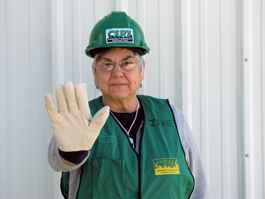home | north bay bohemian index | news | north bay | news article

Photograph by Suzanne Daly
STOP IN THE NAME OF LOVE: CERT volunteer Zeke Britton has trained to help the community in case of emergency. Because she can.
The Real First Responders
Citizens train to help out in times of disaster when emergency crews simply cannot respond
By Suzanne Daly
Zeke Britton looked on in horror as a man lay face down in a busy street, speeding cars narrowly missing him. She and a few others ran to his assistance. As one of them, an EMT, took charge, Britton quickly assessed the situation. Realizing that an emergency vehicle would not be able to get through the traffic jam that had formed, she began directing traffic.
"I did the best I could without much experience," Britton says. "I did fine for 20 minutes until I lost direct eye contact with the drivers in the line of traffic when I glanced back at the emergency situation. Then people started going around me the wrong way until a fireman came and took over. That was the moment I decided to take an advanced CERT course in traffic control, because I realized it would be very useful in situations like these." After a three-hour class and practical experience with cars in a parking lot, Britton now holds a steady gaze while signaling cars with her white-gloved hands.
Community Emergency Response Team (CERT) training programs aim to prepare individuals in basic survival techniques after a catastrophic disaster, until first responders can come to their assistance. Earthquakes, floods or fires could affect the area with significant damage to the infrastructure of the communities. "The key to the CERT program is that the volunteers activate their services in their own neighborhood, to take care of themselves and their neighbors until first responders can get there," says Jim Bray, Sonoma County CERT volunteer coordinator. "The biggest goal is to teach safety; it's almost more about what not to do than what to do. It's about how to prepare your home so that you don't become a victim and you can survive, especially in isolated communities." The CERT program started in L.A. after the Northridge earthquake in the '90s. It grew from a citywide organization to a national program.
Britton became interested in 2006, after reflecting on the disastrous effects of Hurricane Katrina. "It became clear that no matter how hard the emergency people wanted to get through, they couldn't always do that," she says. "When there is a big disaster, there are so many things that emergency teams have to secure, like the water supply and clearing the streets. They may not get out to the neighborhoods for a few days, so there's a need for citizens to take care of themselves and each other until help can come."
Training in CERT is a combination of classroom work and practical exercises, focusing on skills such as disaster preparedness; fire safety, including use of an extinguisher; first aid and medical triage; light search and rescue, and extraction. Volunteers are also trained in deciding whether to enter a building or not and direction on how to get a person safely out.
After some 27 hours of training, the "final exam" is a simulated disaster, complete with "victims" in moulage, makeup that replicates injuries. Graduates are gifted a CERT "go kit," a backpack which contains a hard hat, vest, whistle, flashlight, a wrench to turn off gas and other emergency supplies. Advanced CERT classes offered include ham radio use, dealing with terrorism, how to run a disaster shelter, moulage and urban wildfires.
The Sonoma County CERT teams have been established for about five years but haven't dealt with any large catastrophes in the area yet. "The folks most likely to volunteer are those who live outside of towns in more isolated areas. They realize that they may be more cut off from help in times of disasters, so have a strong reason for preparedness," Bray says. "Whenever a disastrous event occurs, interest peaks and more volunteers come out to be trained. People become fairly complacent otherwise," he says wryly.
An all-volunteer organization, CERT works in conjunction with community fire departments. Volunteers are an equal mix of women and men, ages 18 and older. The program aims for its trainees to go back to their neighborhoods and help organize them, so the folks living there know how many people and pets live in each household, if there are specific medical needs to be aware of, and what skills (medical, building, etc.) or tools (chainsaws, generators, axes, etc.) people have that might aid in an emergency.
"The people we want to train are those who would be the least likely to get involved in emergency situations; the ones who are afraid to use a fire extinguisher or are worried about their ability to survive an earthquake," Bray says. "The training gives them the confidence that they can survive and find their way out of a difficult situation. It's a big advantage to teach those least likely to volunteer, because it limits those who would be victims."
To learn more about CERT in Sonoma County, go to www.sccert.org; in Marin, www.xmrfire.org; in Napa, www.napavalleycert.com.
Send a letter to the editor about this story.
|
|
|
|
|
|